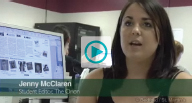Contemporary Journalism in the TV and Internet Age
In the early 1980s, a postmodern brand of journalism arose from two important developments. In 1980 the Columbus Dispatch became the first paper to go online; today, nearly all U.S. papers offer some Web services. Then the colorful USA Today arrived in 1982, radically changing the look of most major U.S. dailies.
USA Today Colors the Print Landscape
USA Today made its mark by incorporating features closely associated with postmodern forms, including an emphasis on visual style over substantive news or analysis and the use of brief news items that appealed to readers’ busy schedules and shortened attention spans.
“Too many blog posts begin with ‘I heard that …’ and then launch into rants and speculation. No phone calls, no emails, no interviews to find out if what they heard is true. It’s the Internet version of the busybody neighbor, except far less benign.”
CONNIE SCHULTZ, PULITZER PRIZE-WINNING COLUMNIST FOR CLEVELAND PLAIN DEALER, 2010
Now the second most widely circulated paper in the nation, USA Today represents the only successful launch of a new major U.S. daily newspaper in the last several decades. Showing its marketing savvy, USA Today was the first paper to openly acknowledge television’s central role in mass culture: The paper used TV-inspired color and designed its first vending boxes to look like color TVs. Even the writing style of USA Today mimics TV news by casting many reports in present tense rather than the past tense (which was the print-news norm throughout the twentieth century).
Writing for Rolling Stone in March 1992, media critic Jon Katz argued that the authority of modern newspapers suffered in the wake of a variety of “new news” forms that combined immediacy, information, entertainment, persuasion, and analysis. Katz claimed that the news supremacy of most prominent daily papers, such as the New York Times and the Washington Post, was being challenged by “news” coming from talk shows, television sitcoms, popular films, and even rap music. In other words, we were changing from a society in which the transmission of knowledge depended mainly on books, newspapers, and magazines to a society dominated by a mix of print, visual, and digital information.
Online Journalism Redefines News
What started out in the 1980s as simple, text-only experiments for newspapers developed into more robust Web sites in the 1990s, allowing newspapers to develop an online presence. Today, online journalism is completely changing the industry. First, rather than subscribing to a traditional paper, many readers now begin their day on their iPads, smartphones, or computers scanning a wide variety of news Web sites, including those of print papers, cable news channels, newsmagazines, bloggers, and online-only news organizations. Such sources are increasingly taking over the roles of more traditional forms of news, helping to set the nation’s cultural, social, and political agendas. One of the biggest changes is that online news has sped up the news cycle to a constant stream of information and has challenged traditional news services to keep up. For instance, Matt Drudge, the conservative Internet gossip and news source behind the Drudge Report, hijacked the national agenda in January 1998 and launched a scandal when he posted a report that Newsweek had delayed the story about President Clinton’s having an affair with White House intern Monica Lewinsky.
VideoCentral  Mass Communication
Mass Communication

Newspapers and the Internet: Convergence This video discusses the ways newspapers are adapting to online delivery of news.
Discussion: What different kinds of skills are needed to be effective in the new online world? What skills might remain the same?
Another change is the way nontraditional sources and even newer digital technology help drive news stories. For example, the Occupy Wall Street (OWS) movement, inspired by the Arab Spring uprisings, began in September 2011 when a group of protestors gathered in Zuccotti Park in New York’s financial district to express discontentment with overpaid CEOs, big banks, and Wall Street, all of whom helped cause the 2008–09 financial collapse but still enjoyed a government bailout.
Mainstream media was slow to cover OWS, with early coverage simply pitting angry protesters against dismissive Wall Street executives and politicians, many of whom questioned the movement’s longevity as well as its vague agenda. But as retirees, teachers, labor unions, off-duty police officers, firefighters, and other government workers joined the college students, the jobless, and the homeless in OWS protests across the country, the coverage and narratives in the media became more complicated and nuanced. As in the Arab uprisings, sites like Tumblr, Facebook, and Twitter became key organizational tools. But more than that, they became alternative media sources, documenting incidents of police brutality and arrests, and covering the issues protestors championed. In both the Arab Spring and OWS stories, the Internet and social media gave ordinary people more agency than ever before. Still, it’s important to remember that while successful movements need good communication and media coverage, they also require enough people willing to challenge power, just as they did in the days of the American Revolution and the Civil Rights movement.
In the digital age, newsrooms are integrating their digital and print operations, and asking their journalists to tweet breaking news that links back to newspapers’ Web sites. However, editors are still facing a challenge to get reporters and editors to fully embrace what news executives regard as a reporter’s online responsibilities. In 2011, for example, executive editor of the New York Times Jill Abramson noted that although the Times had fully integrated its online and print operations, some editors still tried to hold back on publishing a timely story online, hoping that it would make the front page of the print paper instead. “That’s a culture I’d like to break down, without diminishing the [reporters’] thrill of having their story on the front page of the paper,” said Abramson.20 For more about how online news ventures are changing the newspaper industry, see pages 304–306.